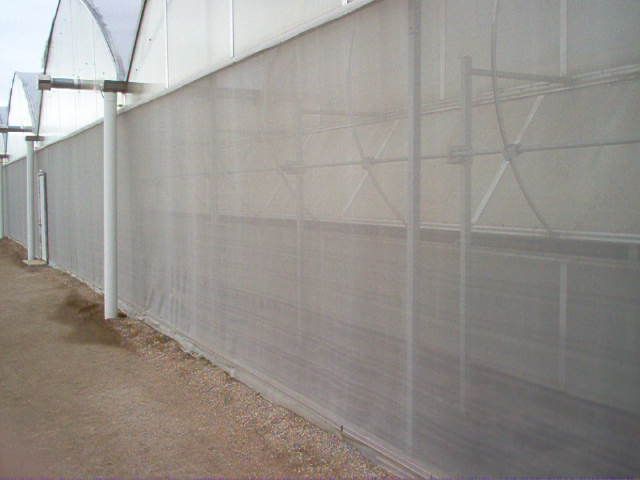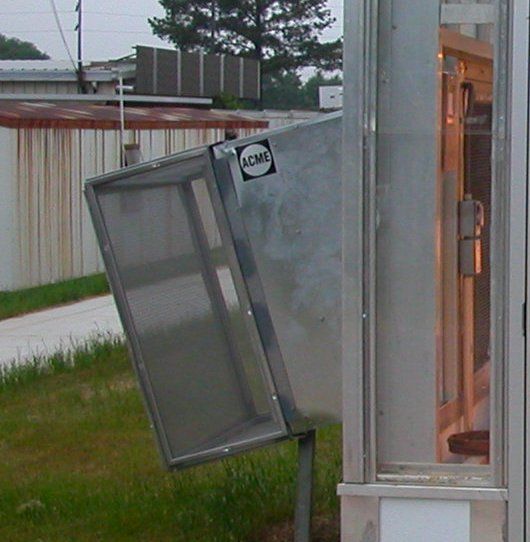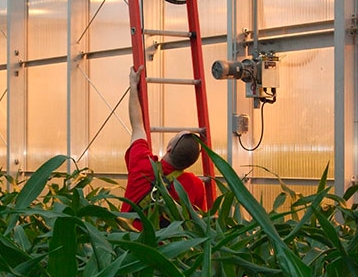Integrated pest management (IPM) in the greenhouse relies on a comprehensive strategy that blends various tools and tactics to manage greenhouse pests and keep diseases under control. Alongside chemical and cultural practices, structural pest control measures play a key role in one of the most effective IPM tactics — prevention.

Physical Barriers: Use Insect Screens to Bar Entry
Physical barriers, such as ground barriers or insect screening placed over vents, windows, and doorway entrances, have long been used by growers to keep harmful greenhouse pests from entering growing areas.
Insect screening helps reduce pesticide use and proves especially beneficial for growers who produce crops without the help of chemical controls or have restrictions on the chemical controls they can use.
When selecting your screens, you must keep the hole sizes of your mesh and airflow through the screen material in mind. And know that balancing hole size and airflow will inevitably involve making some tradeoffs.
The type of greenhouse pest(s) you want to exclude determines what hole size you will need, so you want to consider the size of the smallest insect you want to keep out.
The smaller the hole size of the mesh, the more restrictions on airflow. Screens that block too much airflow can negatively affect your greenhouse climate and crops and cause your fans to work harder.
Proper screen installation allows for screening to cover enough overall surface area so as not to impede air circulation.
Note that certain screen manufacturers offer fabrics with optical properties that repel greenhouse pests from screening, thereby excluding them without the need for finer hole sizes.
Also, some greenhouse coverings can reduce the insect’s ability to navigate once in the greenhouse. For example, the use of ultraviolet (UV)-absorbing plastics for greenhouse coverings can contribute to a decrease in insect populations because the UV-free light can play havoc with insects’ landing and feeding behaviors to help reduce the spread of insect-vectored viruses1.
Work with a supplier of your choice to determine the best type of insect screening for your growing needs. They can help you ensure you have the right balance between hole size and airflow.
Proper Ventilation Disrupts Behavior of Greenhouse Pests

The impact of greenhouse ventilation on pests is often overlooked. A greenhouse lacking proper air circulation creates a warm, humid environment rich with stale air where pests thrive, and diseases spread.
When air circulates properly in the greenhouse, the movement created by the constant airflow makes it harder for insects to settle on plants and disrupts their flight. Plant foliage stays drier, which helps with disease control. Plants also stay healthier, so they are less vulnerable to pest and disease attacks.
According to Matt Lollar, Commercial Horticulture Agent at the University of Florida Extension (IFAS) in Santa Rosa County, greenhouse growers can adopt a tactic used by outdoor growers: employing ultra-violet reflective mulch. This mulch is effective in deterring and confusing greenhouse pests attempting to enter through ventilation systems.
Lollar recommends installing the mulch over a minimum 20-foot-wide area of ground starting at the ventilation air intake end wall. Additionally, placing mulch along the sidewalls can contribute to repelling insect pests1.
Regular Greenhouse Maintenance Is Critical for Prevention
Your greenhouse itself can be your first line of defense for pest and disease control, but only if you keep up with its maintenance and clean and sanitize it regularly.

Here’s a short checklist to get you started:
- Schedule regular deep cleaning and sanitation of your greenhouses
- Disinfect and sanitize irrigation lines and storage tanks to prevent algae build-up. Keep hose ends off the ground.
- Keep greenhouse floors clean and free of algae
- Clear greenhouses of weeds, plant debris, or scattered soil that can host insects
- Disinfect and sanitize benches, potting materials, and equipment
- Inspect greenhouse frames, doors, glazing panels, knee walls, and foundations for any gaps, cracks, or crevices that need filling. Keep an eye out for missing bolts or loose joints.
- Inspect insect screens and greenhouse coverings for tears or holes
- Identify areas with puddling or drainage issues that need repair
- Inspect your ventilation system to ensure it is working properly
- Keep storage areas clean
References Cited
- Lollar, M. (2018, February 9). Managing Greenhouse Insect Pests Through Exclusion Techniques. IFAS Extension University of Florida. Retrieved January 15, 2024, from https://nwdistrict.ifas.ufl.edu/phag/2018/02/09/managing-greenhouse-insect-pests-through-exclusion-techniques/
Bibliography
- Bartok, J. (2016) Insect Screening: An Important Pest Management Tool. Greenhouse Management.
- National Greenhouse Manufacturers Association. Insect Screening.
- National Greenhouse Manufacturers Association. (2002) Structure Basics, Part II: Using Insect Screening. Greenhouse Product News (GPN).
- Schnelle, M. and Rebek, E. (2017) IPM in the Greenhouse Series: Integrated Pest Management in Commercial Greenhouses: An Overview of Principles and Practices. OSU Extension/Oklahoma State University.
Explore our comprehensive solutions and expert services to optimize your commercial greenhouse and help you maintain a pest-free environment for your crops. Contact us at [email protected]
Be the first to write a comment.